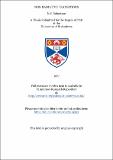Files in this item
Non-radiative transitions
Item metadata
| dc.contributor.advisor | Friedman, Lionel Robert | |
| dc.contributor.author | Robertson, Neil | |
| dc.coverage.spatial | 179 p. | en_US |
| dc.date.accessioned | 2018-06-26T10:26:25Z | |
| dc.date.available | 2018-06-26T10:26:25Z | |
| dc.date.issued | 1977 | |
| dc.identifier.uri | https://hdl.handle.net/10023/14593 | |
| dc.description.abstract | This thesis describes theoretical research into multiphonon non-radiative transitions in solids. These processes occur when an impurity centre electron which has been raised to an excited state returns to its ground state by emitting phonons into the lattice rather than by emitting light. The original contribution of this thesis is concerned with certain theoretical aspects of non-radiative transitions. For the first time the Molecular Crystal Model originally developed by Holstein to study small-polaron motion is used to investigate this problem. In particular, the effect that weak dispersion of the vibrational modes has on the transition rates is studied. The inclusion of weak dispersion is essential for a rigorous treatment of non-radiative transitions, and without this feature the transition rates are not well defined. We also use the well-known single configuration coordinate model to derive recombination rates, giving particular attention to the unequal frequency case. Finally an adaptation of the Molecular Crystal Model is considered which more closely resembles real physical systems in that the electron is coupled to both crystalline modes and a local mode. | en_US |
| dc.language.iso | en | en_US |
| dc.publisher | University of St Andrews | |
| dc.subject.lcc | QC176.8E9R7 | |
| dc.subject.lcsh | Exction theory | en |
| dc.title | Non-radiative transitions | en_US |
| dc.type | Thesis | en_US |
| dc.type.qualificationlevel | Doctoral | en_US |
| dc.type.qualificationname | PhD Doctor of Philosophy | en_US |
| dc.publisher.institution | The University of St Andrews | en_US |
This item appears in the following Collection(s)
Items in the St Andrews Research Repository are protected by copyright, with all rights reserved, unless otherwise indicated.

